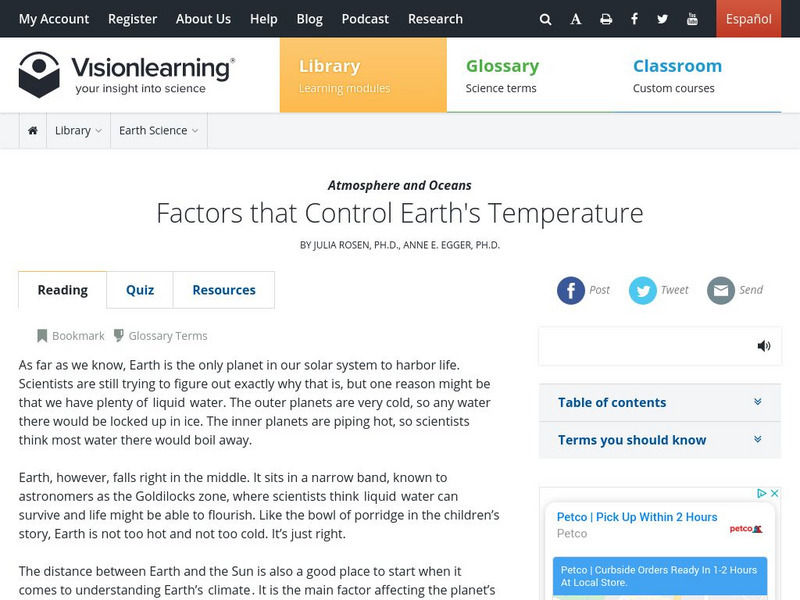Hi, what do you want to do?
Columbus City Schools
What is Up Th-air? — Atmosphere
Air, air, everywhere, but what's in it, and what makes Earth's air so unique and special? Journey through the layers above us to uncover our atmosphere's composition and how it works to make life possible below. Pupils conduct...
Beyond Benign
Climate Change Chemistry
Assist your class with learning the importance of caring for our environment as they complete this fun-filled lesson on climate change. Individuals perform simulations related to greenhouse gases, atmospheric gases, and the overall...
Curated OER
Hazards: First Grade Lesson Plans and Activities
Examine the environmental hazards associated with volcanoes with a three-part science lesson. In the pre-lab, first graders learn that gas, landslides, ash, and lava are all hazards that come from volcanoes. They then explore...
Steinhardt Apps
Kinetic Molecular Theory
Building off young chemists' knowledge of the states of matter, kinetic molecular theory is the focus of the unit. Eight days of lessons including multiple demonstrations, one lab experiment, directed instruction, and worksheets,...
King's Centre for Visualization in Science
Explaining Climate Change: Lesson 6: Greenhouse Gases: A Closer Look
This is the sixth lesson in a series of learning modules on the topic of climate change. It takes a look at the different important greenhouse gases in our atmosphere and some of the ways in which humanity is affecting the atmospheric...
Vision Learning
Visionlearning: Earth Science: Earth's Atmosphere: Composition and Structure
Instructional module focusing on Earth's atmosphere. Discussion includes major components, layers, air pressure, and scientific monitoring of the atmosphere. Site also includes an interactive practice quiz and links relating to the topic.
Vision Learning
Visionlearning: Atmosphere and Oceans: Factors That Control Earth's Temperature
An explanation of how temperature is affected by the composition of the atmosphere and how energy flows in and out of Earth's atmosphere.
King's Centre for Visualization in Science
Explaining Climate Change: Lesson 2: Is Climate Change Happening?
This is the second lesson in a series of learning modules on the topic of climate change. It examines what climate change is, how it relates to greenhouse gas concentrations over time, and temperature trends. Includes comprehension...
King's Centre for Visualization in Science
Explaining Climate Change: Lesson 3: The Chemistry of the Greenhouse Effect
This is the third lesson in a series of learning modules on the topic of climate change. It takes a look at how greenhouse gases cause warming and affect Earth's climate. Includes comprehension questions and interactive tools for...
Sophia Learning
Sophia: The Biosphere: Lesson 3
This lesson will discuss the importance of the biosphere (the global ecosystem) to living things. It is 3 of 3 in the series titled "The Biosphere."
Sophia Learning
Sophia: The Biosphere: Lesson 1
This lesson will discuss the importance of the biosphere (the global ecosystem) to living things. It is 1 of 3 in the series titled "The Biosphere."
University of Colorado
University of Colorado: Ph Et Interactive Simulations: The Greenhouse Effect
How do greenhouse gases affect the climate? Explore the atmosphere during the ice age and today. What happens when you add clouds? Change the greenhouse gas concentration and see how the temperature changes. Then compare to the effect of...
TeachEngineering
Teach Engineering: Air Pollution
Students are introduced to the concept of air quality by investigating the composition, properties, atmospheric layers and everyday importance of air. They explore the sources and effects of visible and invisible air pollution. By...
















